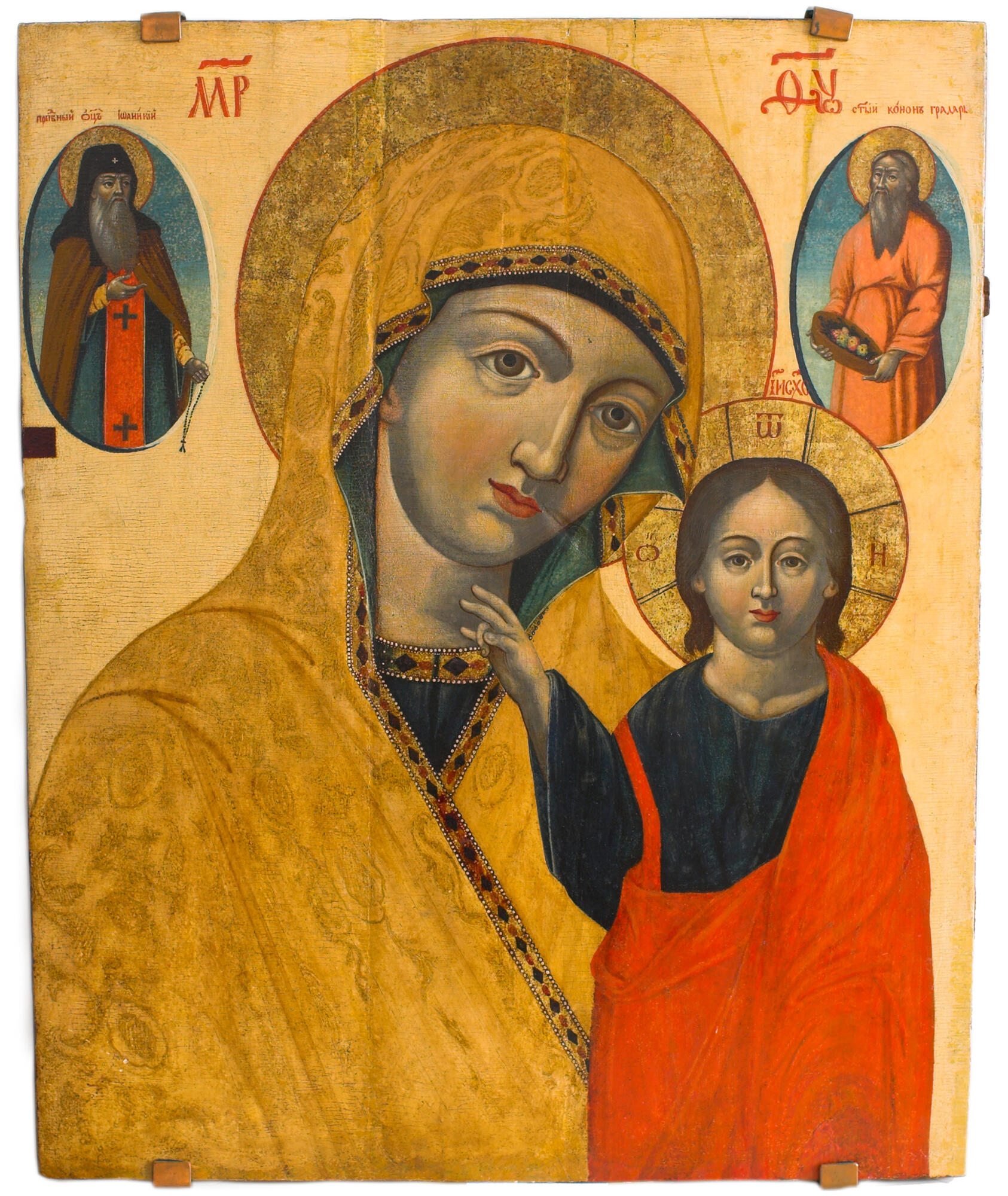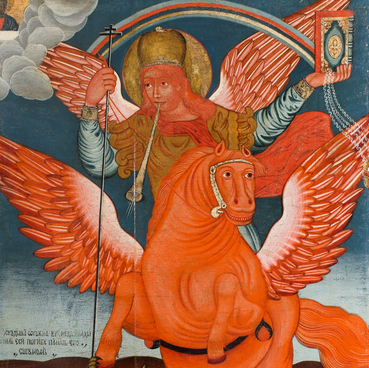It is believed that the iconography of this icon appeared in the 17th century to commemorate a miraculous event that occurred in Tobolsk in 1661. There is a story about the Appearance of the Kazan icon of the Mother of God in Tobolsk. It describes the misfortune and natural disasters which the city was suffering from because its inhabitants treated the icon improperly: the shrine was abandoned and kept in a storage closet, where it stood facing the wall. According to the legend, the local verger Ioannicus had a vision of the Metropolitan Philip, who had been canonized shortly before this event. He pointed out to the verger that the icon should not be treated like this. And he also ordered the verger to tell the city authorities: to atone the sins of Tobolsk citizens, a Church should be built on a high place in the name of the Kazan icon of the Mother of God, and on the day of its consecration, the abandoned icon should be brought into this church.
As the legend says, the church was built in three days and consecrated on the fourth day. As it was described in the story, before the construction of the church the city had been suffering from pounding rains, crops and cattle died out. And when the ancient icon found its new home, the local dwellers appealed to the mother of God with a prayer ‘… Oh, the most pure Virgin, save us with your mercy! …Merciful Queen, ask your Son, Jesus Christ, our Lord, to avert his righteous wrath and preserve the city and people in peace and prosperity, and save the fruits of the earth.’ The rain stopped, and the crops and vegetables were saved.
This icon belongs to the iconographic type ‘Odigitria’ — from Greek this word is translated as a ‘guide’. According to the legend, the first icon like this was painted by Luke during the life of the Virgin Mary’s lifetime.
Unlike icons like “Eleusa” or “Tenderness”, which show the love between Mother and Baby snuggling up to her cheek, here in the center of the composition we see the Son of God himself. He is facing the audience and blesses them with his right hand. The Mother of God usually points to Christ as to the path to salvation. However, in this icon you cannot see this: Virgin Mary is depicted here only to the shoulders. Another feature of the Kazan icon is that Christ is standing, and his left hand is hidden by a robe.
In this icon, the Mother of God is depicted wearing a light golden maforia, a long female veil, with golden herb and flower patterns. The edge of the maforia and the collar of the tunic is decorated with a rombic ornament. Jesus Christ is wearing bright red himation - a piece of clothing made of a rectangular piece of fabric.
Images of the saints are painted inside oval-shaped stamps. Inside the left stamp there is St. Ioannicus the Great, the saint patron of verger Ioannicus. Inside the right stamp there is St. Konon, who was usually addressed with a prayer about giving more fruits of the earth, he is holding a basket of vegetables or fruit.
The features of the Siberian iconographic style included the unusual color of the icon: a light background, pink-grayish color of faces instead of conventional ochre shades. The icon was created at the end of the 18th century and has some typical features of that period of time, when the signs of secular art culture began to penetrate the canonical iconography. The artwork was restored in 1990.
As the legend says, the church was built in three days and consecrated on the fourth day. As it was described in the story, before the construction of the church the city had been suffering from pounding rains, crops and cattle died out. And when the ancient icon found its new home, the local dwellers appealed to the mother of God with a prayer ‘… Oh, the most pure Virgin, save us with your mercy! …Merciful Queen, ask your Son, Jesus Christ, our Lord, to avert his righteous wrath and preserve the city and people in peace and prosperity, and save the fruits of the earth.’ The rain stopped, and the crops and vegetables were saved.
This icon belongs to the iconographic type ‘Odigitria’ — from Greek this word is translated as a ‘guide’. According to the legend, the first icon like this was painted by Luke during the life of the Virgin Mary’s lifetime.
Unlike icons like “Eleusa” or “Tenderness”, which show the love between Mother and Baby snuggling up to her cheek, here in the center of the composition we see the Son of God himself. He is facing the audience and blesses them with his right hand. The Mother of God usually points to Christ as to the path to salvation. However, in this icon you cannot see this: Virgin Mary is depicted here only to the shoulders. Another feature of the Kazan icon is that Christ is standing, and his left hand is hidden by a robe.
In this icon, the Mother of God is depicted wearing a light golden maforia, a long female veil, with golden herb and flower patterns. The edge of the maforia and the collar of the tunic is decorated with a rombic ornament. Jesus Christ is wearing bright red himation - a piece of clothing made of a rectangular piece of fabric.
Images of the saints are painted inside oval-shaped stamps. Inside the left stamp there is St. Ioannicus the Great, the saint patron of verger Ioannicus. Inside the right stamp there is St. Konon, who was usually addressed with a prayer about giving more fruits of the earth, he is holding a basket of vegetables or fruit.
The features of the Siberian iconographic style included the unusual color of the icon: a light background, pink-grayish color of faces instead of conventional ochre shades. The icon was created at the end of the 18th century and has some typical features of that period of time, when the signs of secular art culture began to penetrate the canonical iconography. The artwork was restored in 1990.



